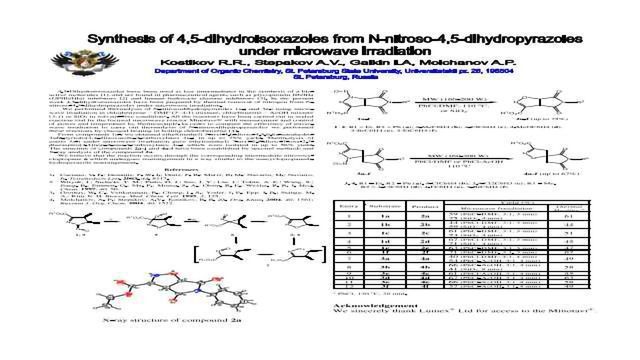Latest Posters

Poster
A Software-Aided Approach to Reducing the Synthetic Burdens of Lead Structure Optimization
Following the identification of a lead compound, the usual next step is optimization of that lead via slight structural modifications to improve or retain potency while simultaneously minimizing liabilities. Achieving this balance of required properties is a significant challenge. ACD/Structure Design Suite is a software tool that significantly helps the medicinal compounds that are expected to produce analogs with improved selected physicochemical properties.

Poster
Medicinal Chemistry Tools: Making Sense of HTS Data
High throughput screening (HTS) is an expensive part of the drug development process. Increasing the efficiency and productivity of HTS is a key objective for today’s discovery organizations. Predictive technology can be used to direct the screening of compounds prior to synthesis. However, issues such as the small proportion (usually less than 1%) of hits that occur in a given assay, complicate the application of statistical analysis and predictive modeling to this data.

Poster
Automated, Low Volume Dynamic Light Scattering Technology to Accelerate Protein Crystallization
The quest for solving protein structure largely relies upon X-Ray diffraction, a method requiring crystalline forms of the target protein. Among the many steps comprising structure determination, the process of protein crystallization represents one of the most significant, time-consuming challenges. A new low sample volume, automated dynamic light scattering (DLS) technology has been developed – the DynaPro Plate Reader.

Poster
Gene Experssion-based Prediction and Mechanistic Assessment of Non-Genotoxic Chemical-Induced Hepatocarcinogenicity
To facilitate both prediction and mechanism-based assessment of human cancer risk, a liver gene expression signature was derived from short term experiments in the rat to predict non-genotoxic hepatocarcinogenicity. The signature was shown to classify 47 independent chemicals with 85% accuracy, much greater than other putative early biomarkers.

Poster
Synthesis of 4,5-dihydroisoxazoles from N-nitroso-4,5 dihydropyrazoles under Microwave Irradiation
4,5-Dihydroisoxazoles have been used as key intermediates in the synthesis of a bioactive molecules and are found in pharmaceutical agents such as glycoprotein IIb/IIIa (GPIIb/IIIa) inhibitors and human leukocyte elastase inhibitors. In the present work 4,5-dihydroisoxazoles have been prepared by thermal removal of nitrogen from N-nitroso-4,5-dihydropyrazoles under microwave irradiation.

Poster
Simplifying the Flow of Drug Discovery Data
Regardless of research disciplines, scientists need to easily reach the information pertinent to their research. Ideally this data access is easy. Researchers also need the ability to ‘move the data around’ to gain a better view or different perspective. This data manipulation needs to be straightforward. Incorporating the varying views and information required by different scientific disciplines is a considerable challenge.

Poster
Combined Immune Parameters and X-ray data in Early Prediction of Anti-Tuberculosis Chemotherapy Response
20 tuberculosis (12 slow-responders and 8 fast responders) patients were treated with directly observed short course anti-tuberculosis chemotherapy. Chest X-ray was performed. sICAM-1 and suPAR were measured in serum by ELISA, TNFRs using the luminex technology. General discrimination analysis on selected analytes gave, 91.66% and 87,50% correctly classify fast responders and slow responder respectively. The support vector machine analysis gave 100% correct classification.

Poster
The Effect of Microwave Irradiation Towards Carbodiimide-Mediated Esterifications on Solid Phase
A number of publications have reported the coupling of carboxylic acids to Merrifield resin via the cesium salt method and the esterification of Wang resin using carbodiimide either via the isourea method or the symmetrical anhydride method. Reaction times using conventional conditions have been reported to be rather long so we have investigated the effects of microwave irradiation towards both of these reactions using benzoic acid derivatives.

Poster
Development of High-Throughput PAMPA as an In Vitro Model of Passive Transcellular Permeation
The absorption of orally administered compounds is largely determined by their ability to cross the gastrointestinal tract. Cell culture models can be intensive and limited to a narrow pH range. Assays using artificial membranes, such as PAMPA (parallel artificial membrane permeation assay) can be used as an alternative approach to assess in vitro transcellular passive permeation.

Poster
A Strategy to Investigate Potential Pro-Arrhythmic Effects of Compounds During the Drug Discovery and Development Process
For pharmaceutical companies it is not only essential to identify HERG interacting compounds early during the drug discovery and development process, but also to understand potential effects of compounds on the cardiac action potential. This helps to increase the safety for patients, and to avoid the costs of unsuccessful projects in later phases.
Advertisement

